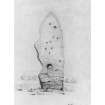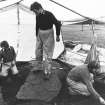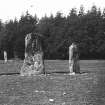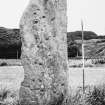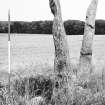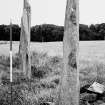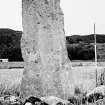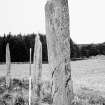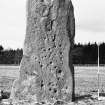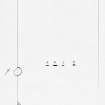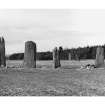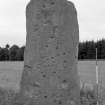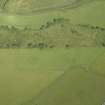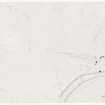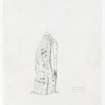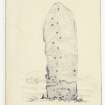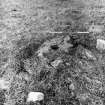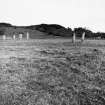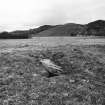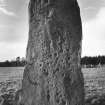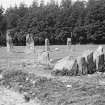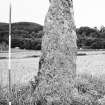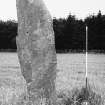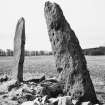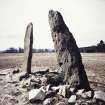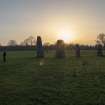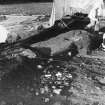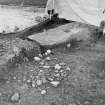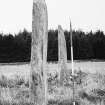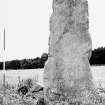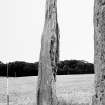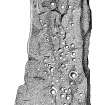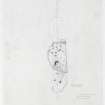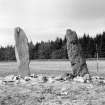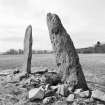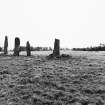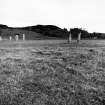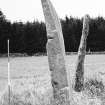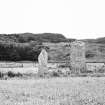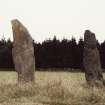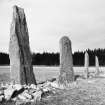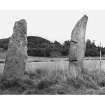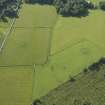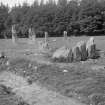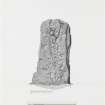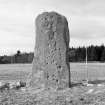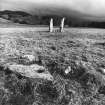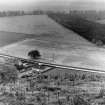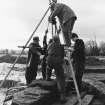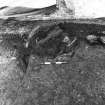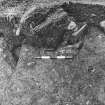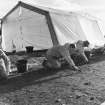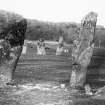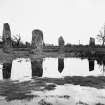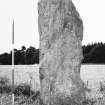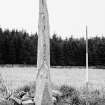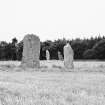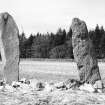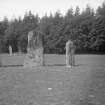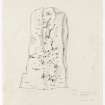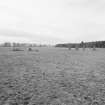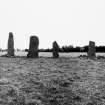Following the launch of trove.scot in February 2025 we are now planning the retiral of some of our webservices. Canmore will be switched off on 24th June 2025. Information about the closure can be found on the HES website: Retiral of HES web services | Historic Environment Scotland
Ballymeanoch
Cup Marked Stone (Prehistoric), Standing Stone(S) (Prehistoric)
Site Name Ballymeanoch
Classification Cup Marked Stone (Prehistoric), Standing Stone(S) (Prehistoric)
Alternative Name(s) Kilmartin Glen
Canmore ID 39454
Site Number NR89NW 14
NGR NR 8337 9641
Datum OSGB36 - NGR
Permalink http://canmore.org.uk/site/39454
First 100 images shown. See the Collections panel (below) for a link to all digital images.
- Council Argyll And Bute
- Parish Kilmichael Glassary
- Former Region Strathclyde
- Former District Argyll And Bute
- Former County Argyll
NR89NW 14 8337 9641.
(NR 8337 9641) Standing Stones (NR) (7 shown)
OS 6" map, Argyllshire, 1st ed., (1874)
Seven stones in two lines, including an outlier to NW, fallen since 1881. The fallen stone has many cups on its hidden side ('C' on Allen illust) and is perforated. Three of the line of four stones are cup marked, but no certain rings (Campbell and Sandeman 1964). However, Allen's illustration of stones A and B on plan shows cup and ring marks.
J R Allen 1882; M Campbell and M Sandeman 1964.
Generally as described. The stones are as illustrated by Allen (1882). Resurveyed at 1:2500.
Visited by OS (I A) 2 May 1973.
These stones are set in one line (A, B, C, D on plan) with a further two (E, F on plan) 45.0m to the SW, and a recumbent outlier (G on plan). All are plain except 'B' which has approx 35 cup marks and 3 cup- and-rings on its east face, and 'C' which has approx 30 cup marks and one cup-and-ring on its west face.
Surveyed at 1/10,000.
Visited by OS (T R G) 5 April 1977.
The cup marked, holed stone, formerly part of the Ballymeanoch complex, has been placed as a cover over a drain beside the kerb cairn. The stone has been placed with cup marks facing upwards. This stone formed part of a scheduled monument.
A Kahane and E Proudfoot 1982.
SDD excavation report.
J W Barber 1980.
Scheduled as 'Ballymeanoch, standing stones... a group of standing stones situated on a gravel terrace on the W side of Kilmartin Glen, 450m to the NW of Ballymeanoch.'
Information from Historic Scotland, scheduling document dated 3 May 2005.
Antiquarian Observation (1850 - 1901)
Drawings by Christian MacLagan of sites across Scotland in the Society of Antiquaries of Scotland Collection at HES.
Excavation (1977)
Stone G fell at some time after 1881, and its stump was excavated and removed in 1977; the shattered remains have been dumped in the drain close to the kerb cairn (NR89NW 40)
(Barber 1980).
Field Visit (June 1979)
This group of standing stones is situated in an arable field 230m SW of Dunchraigaig, 29m SW of the kerb cairn (NR89NW 40) and about 130m NNE of Ballymeanoch henge (NR89NW 18) (Campbell and Sandeman 1964, 24). Originally, there were seven stones, disposed in two roughly parallel linear settings of four stones (A-D) and two stones (E-F) respectively, the seventh (G) being an outlier to the NW. Stone G, however, fell at some time after 1881, and its stump was excavated and removed in 1977; the shattered remains have been dumped in the drain close to the kerb cairn (NR89NW 40) (Barber 1980, 104-11).
The two linear settings are aligned approximately NW-SE, with the long axes of the individual stones parallel to the main alignment. The four E stones (A-D) are graded in height from SE to NW and measure: A, 4.1m high, 1.4m by 0.4m at the base; B, 3.6m high, 2.0m by 0.5m at the base; C, 2.75m high, 0.9m by 0.35m at the base; D, 2.75m high, 1.4m by 0.5m at the base. Two of the stones bear decoration: on the E face of stone B there are at least seventy plain cupmarks, as well as five cups with single rings and gutters, and eight cups with complete or partial single rings, the W face of stone C is decorated with some forty plain cupmarks, one large cup and single ring, and one cup with a gutter and ring (Morris 1977, 55-6).
Standing stones E-F are situated roughly opposite the central stones of the four-stone alignment and are separated from it by a distance of about 41m. As in the E alignment, the taller of the two stones (F) lies on the S; it rises to a height of 3m and measures 0.6m by 0.4m at the base, while stone F is 2.7m high and 0.8m by 0.3m at the base.
The excavated stone (G), which stood 18m to the WNW of stone F, rose to a height of 2.85m (Allen 1882, 114-17), with its long axis aligned roughly NW-SE (the published excavation plan erroneously shows the alignment at right angles to the linear settings). An unusual feature of the stone was an hour-glass perforation through its centre, which was probably at least partially man-made. Like stones A, B and C, it was decorated, bearing on its E face two large cupmarks, about fifteen smaller cups and a dumb-bell. Excavation around the stump of the stone, which had remained in the ground after the upper portion had fallen, revealed three small patches of cremated bone, probably buried as a foundation deposit when the stone was erected.
Visited June 1979
RCAHMS 1988
Measured Survey (June 1979)
RCAHMS surveyed Ballymeanoch standing stones on June 1979 with plane-table and alidade producing a plan at a scale of 1:100. The plan of the standing stones was redrawn in ink and published at a scale of 1:250 (RCAHMS 1988a, 128).
Geophysical Survey (June 1993)
After ploughing at Ballymeanoch in June 1993 a large flat stone was uncovered. It lies half buried in a NW to SE orientation with the NW half and part of the southern corner revealed. The stone appears to measure 1250mm by 650mm and about 300mm broad.
With reference to the location plan of Ballymeanoch Standing Stones (RCAHMS 1988), the stone lies 9.7m SE of Stone E and 38.5m SW of Stone A and appears to be in alignment with Stones E and F.
A geophysical survey was also made by GUARD in 1993 at Ballymeanoch, 64 grids, each 20m by 20m being surveyed. A large number of potential anomalies were detected, but only excavation can confirm their interpretation.
D Abernethy 1993
Excavation (1995)
NR 833 964 and NR89NW 18 (Ballymeanoch henge) During April 1995 landscape work was carried out at these sites in order to improve their appearance. This involved the removal of modern clearance stone and the addition of topsoil to cover plough damage on the ground immediately around the monuments. In addition a trench was excavated at the site in order to test the nature of some geophysical anomalies which had been detected in 1993.
Whilst removing the modern clearance stone from around the bases of stones A-D (RCAHMS 1988, 128 Figure A) nothing of additional archaeological interest was encountered. Amongst the clearance stone aound the bases of Stones E and F (RCAHMS 1988, 128 Figure A) were two large flat stones; one measured 0.78m by 0.43m and in one of its corners are two possible eroded cup-marks. The other stone measured 0.66m by 0.32m and was thinner and squarer with a dressed appearance. Both stones were left in situ.
When clearance stones were removed from the ditch around the henge on its W side a large flat stone measuring 1.2m by 0.5m was found. It is suspected that this is the missing northern end slab from the central cist in the Henge. Another smaller, flatter, and much squarer stone was also found in this area of the ditch. It measures 0.5m by 0.3m and may have originally come from the satellite cist. Both stones were left in situ.
Geophysical prospection in 1993 had detected a series of linear anomalies on the same alignment as Stones A-D (RCAMS 1988, 128 Figure A) and running up to meet them at their SE end. A 50m by 1m trench was excavated across these anomolies as there is a good case to suggest that they represent the remains of a prehistoric earthwork avenue. There were no archaeological deposits encountered that might explain the cause of the linear anomalies but a ditch was encountered running N-S. It measured an average of 0.6m across and when sectioned proved to be only an average of 0.11m in depth. No finds were recovered but the W side of this feature contained more stone than the E possibly indicating the presence of packing material for a palisade trench.
Sponsor: Commissioned by Historic Scotland and funded by Kilmartin Glen Project.
D Abernethy 1995.











































































































